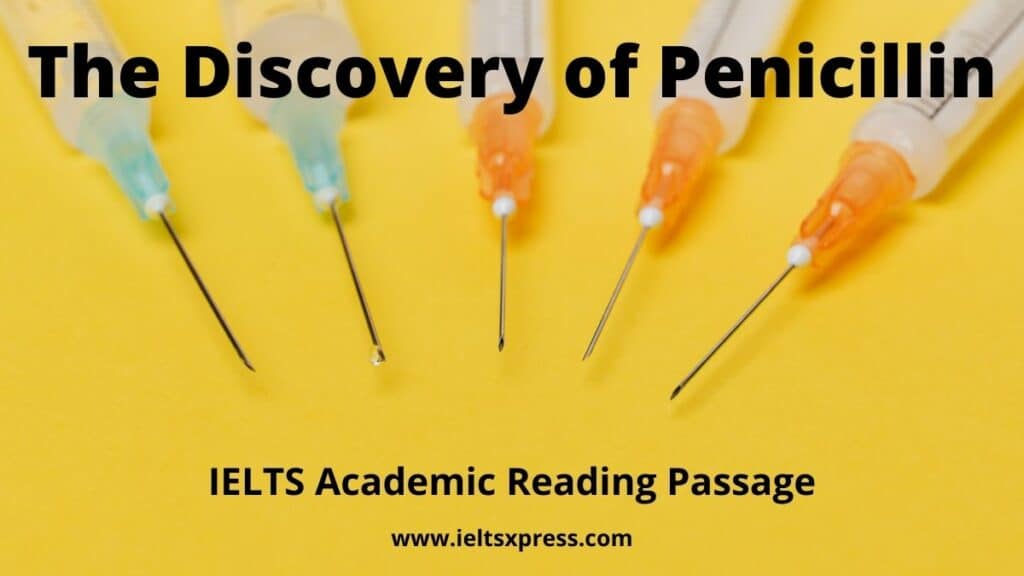The Discovery of Penicillin IELTS Reading Passage with Answers
READING PASSAGE 1
You should spend about 20 minutes on Questions 1-13 which are based on Reading Passage 1 below.
The Discovery of Penicillin
A
The Scottish bacteriologist Dr Alexander Fleming (1881-1955) is credited with the discovery of penicillin in London in 1928. He had been working at St Mary’s Hospital on the bacteriology of septic wounds. As a medic during World War I, he had witnessed the deaths of many wounded soldiers from infection and he had observed that the use of harsh antiseptics, rather than healing the body, actually harmed the blood corpuscles that destroy bacteria.
B
In his search for effective antimicrobial agents, Fleming was cultivating staphylococcus bacteria in Petri dishes containing agar1. Before going on holiday in the summer of 1928, he piled up the agar plates to make room for someone else to use his workbench in his absence and left the windows open. When he returned to work two weeks later, Fleming noticed mould growing on those culture plates that had not been fully immersed in sterilising agent. This was not an unusual phenomenon, except in this case the particular mould seemed to have killed the staphylococcus aureus immediately surrounding it. He realised that this mould had potential.
C
Fleming consulted a mycologist called C J La Touche, who occupied a laboratory downstairs containing many mould specimens (possibly the source of the original contamination), and they concluded it was the Penicillium genus of ascomycetous fungi. Fleming continued to experiment with the mould on other pathogenic bacteria, finding that it successfully killed a large number o+f them. Importantly, it was also non-toxic, so here was a bacteria-destroying agent that could be used as an antiseptic in wounds without damaging the human body. However, he was unsuccessful in his attempts to isolate the active antibacterial element, which he called penicillin. In 1929, he wrote a paper on his findings, published in the British Journal of Experimental Pathology, but it failed to kindle any interest at the time.
D
In 1938, Dr Howard Florey, a professor of pathology at Oxford University, came across Fleming’s paper. In collaboration with his colleague Dr Ernst Chain, and other skilled chemists, he worked on producing a usable drug. They experimented on mice infected with streptococcus. Those untreated died, while those injected with penicillin survived. It was time to test the drug on humans but they could not produce enough – it took 2,000 litres of mould culture fluid to acquire enough penicillin to treat a single patient. Their first case in 1940, an Oxford police officer who was near death as a result of infection by both staphylococci and streptococci, rallied after five days of treatment but, when the supply of penicillin ran out, he eventually died.
E
In 1941, Florey and biochemist Dr Norman Heatley went to the United States to team up with American scientists with a view to finding a way of making large quantities of the drug. It became obvious that Penicillium notatum would never generate enough penicillin for effective treatments so they began to look for a more productive species. One day a laboratory assistant turned up with a melon covered in mould. This fungus was Penicillium chrysogeum, which produced 200 times more penicillin than Fleming’s original species but, with further enhancement and filtration, it was induced to yield 1,000 times as much as Penicillium notatum. Manufacture could begin in earnest.
F
The standardisation and large-scale production of the penicillin drug during World War II and its availability for treating wounded soldiers undoubtedly saved many lives. Penicillin proved to be very effective in the treatment of pneumococcal pneumonia – the death rate in WWII was 1% compared to 18% in WWI. It has since proved its worth in the treatment of many life-threatening infections such as tuberculosis, meningitis, diphtheria and several sexually-transmitted diseases.
G
Fleming has always been acknowledged as the discoverer of penicillin. However, the development of a commercial penicillin drug was due to the skill of chemical scientists Florey, Chain and others who overcame the difficulties of converting it into a usable form. Fleming and Florey received knighthoods in 1944 and they, together with Chain, were awarded the Nobel Prize in Physiology or Medicine in 1945. Heatley’s contribution seems to have been overlooked until, in 1990, he was awarded an honorary doctorate of medicine by Oxford University – the first in its 800-year history.
H
Fleming was mindful of the dangers of resistance to penicillin early on and he expressly warned on many occasions against overuse of the drug, because this would lead to bacterial resistance. Ironically, the occurrence of resistance is pushing the drive today to find new, more powerful antibiotics.
—————–
1agar is a culture medium based on a seaweed extract – used for growing microorganisms in laboratories
Questions 1-6
Reading Passage 1 has eight paragraphs, A–H.
Which paragraph contains the following information?
Write the correct letter, A–H, in boxes 1–6 on your answer sheet.
1 results of animal experiments
2 recognition of the scientists’ valuable work
3 a statement about the beginning of mass production
4 Fleming’s cautionary advice
5 examples of uses for penicillin
6 the starting point for Fleming’s original research
Questions 7–10
Complete the summary below.
Choose NO MORE THAN TWO WORDS from the passage for each answer.
Write your answers in boxes 7–10 on your answer sheet.
Dr Fleming’s Accidental Discovery
In a bid to find a safe and effective antiseptic, Dr Fleming was growing staphylococcus aureus bacteria in his lab. On his return from 7_________, he found mould on an unsterilised plate and saw that it had destroyed the bacteria around it. A 8_________ helped him identify the mould. Fleming found that it was active against several different 9_________ and, because it was 10_________, it was safe to use in humans.
Questions 11–13
Complete the table below.
Choose NO MORE THAN TWO WORDS from the passage for each answer.
Write your answers in boxes 11–13 on your answer sheet
Timeline
1928 Fleming’s discovery of penicillin
1929 Fleming’s research published
1938 Florey begins work on penicillin
1940 The first human subject 11_________
1941 Collaboration with 12_________
1944 Two of the scientists are knighted
1945 Three of them share a 13_________
The Discovery of Penicillin IELTS Reading Answers
1. D
2. G
3. E
4. H
5. F
6. B
7. holiday
8. mycologist
9. (pathogenic) bacteria
10. non-toxic
11. (eventually) died
12. American scientists
13. Nobel Prize
Also Check: Neutrinos Sudbury Installation IELTS Listening






1 thought on “The Discovery of Penicillin IELTS Reading with Answers”
I need to getas many reading practice test please mail it to me